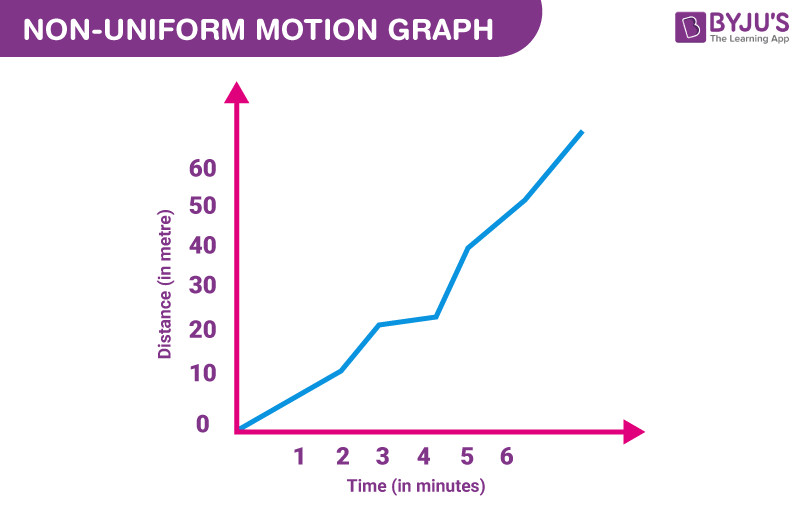Definition: Uniform motion is a fundamental concept in physics that describes the movement of an object traveling in a straight line at a constant speed. In simpler terms, an object in uniform motion covers the same distance in equal intervals of time, regardless of how long those intervals are. This means its velocity remains unchanged throughout its motion.
 An illustration depicting uniform motion with a car moving at a constant speed along a straight road.
An illustration depicting uniform motion with a car moving at a constant speed along a straight road.
A key characteristic of uniform motion is that the object experiences zero acceleration. Acceleration is the rate of change of velocity. If velocity is constant, there is no change in velocity, and therefore, no acceleration. This principle holds true for objects moving in a straight line, also known as rectilinear motion, under uniform conditions.
Examples of Uniform Motion in Everyday Life
To better grasp the concept, let’s consider some practical examples of uniform motion:
-
A Car on Cruise Control: Imagine a car driving on a perfectly straight and level highway with its cruise control set to a specific speed, say 60 miles per hour. If the car maintains this speed without any fluctuations, it is exhibiting uniform motion. It will cover 60 miles every hour.
-
The Blades of a Ceiling Fan: Once a ceiling fan reaches its steady operating speed, the tips of its blades move in uniform circular motion. While the direction is constantly changing (making it circular motion, not strictly rectilinear), the speed at which each point on the blade travels along its circular path remains constant. For simplification in the context of introducing uniform motion (often initially discussed as linear), we can consider the constant speed of the blade tips as an aspect of uniform motion even if the direction is changing.
-
A Ball Rolling on a Level Surface (Ideally): If you roll a ball on a perfectly smooth and horizontal surface in a vacuum (eliminating friction and air resistance), ideally, it would continue to roll in a straight line at a constant speed indefinitely, demonstrating uniform motion. In reality, friction and air resistance will eventually cause it to slow down.
Contrasting Uniform Motion with Non-Uniform Motion
Understanding uniform motion becomes clearer when we compare it to non-uniform motion.
Definition of Non-Uniform Motion: Non-uniform motion occurs when an object’s speed varies over time, meaning it does not cover equal distances in equal intervals of time. In non-uniform motion, the velocity of the object is changing, which implies the presence of acceleration.
 An illustration depicting non-uniform motion with a car moving at varying speeds along a winding road.
An illustration depicting non-uniform motion with a car moving at varying speeds along a winding road.
Examples of Non-Uniform Motion:
-
Traffic Stop-and-Go: A car driving in city traffic experiences non-uniform motion. It speeds up, slows down, stops at traffic lights, and changes direction. The distance covered in each time interval is inconsistent.
-
A Train Journey: While a train might travel at a relatively constant speed on open tracks, its motion is generally non-uniform. It accelerates when leaving stations, decelerates when approaching them, and may vary speed due to track conditions or signals.
-
A Ball Dropped from Height: When you drop a ball, it starts from rest and its speed increases as it falls due to gravity. This is a classic example of non-uniform motion with constant acceleration (uniform acceleration, but still non-uniform motion in terms of velocity being constant).
Key Differences: Uniform Motion vs. Non-Uniform Motion
| Feature | Uniform Motion | Non-Uniform Motion |
|---|---|---|
| Speed | Constant | Variable |
| Velocity | Constant (magnitude and direction) | Variable (magnitude and/or direction) |
| Acceleration | Zero | Non-zero |
| Distance-Time Graph | Straight Line | Curved Line |
| Distance Covered in Equal Time Intervals | Equal Distances | Unequal Distances |
Uniform Motion vs. Uniform Acceleration: Clearing the Confusion
It’s important to distinguish between uniform motion and uniform acceleration. While uniform motion means zero acceleration (constant velocity), uniform acceleration means that the acceleration is constant, but the velocity is changing at a steady rate.
An object with uniform acceleration will experience non-uniform motion because its speed is continuously increasing (or decreasing) at a constant rate. For instance, a ball falling freely under gravity (ignoring air resistance) experiences uniform acceleration (approximately 9.8 m/s²), but its motion is non-uniform as its speed increases every second.
Exploring Uniform Circular Motion
The concept of uniformity also extends to circular motion. Uniform circular motion describes the movement of an object along a circular path at a constant speed.
 Illustration of Non-Uniform Circular Motion
Illustration of Non-Uniform Circular Motion
In uniform circular motion:
- Speed is constant: The object maintains a steady pace around the circle.
- Velocity is NOT constant: Although the speed is constant, the direction of the velocity is continuously changing as the object moves along the circular path. Since velocity is a vector quantity (having both magnitude and direction), a change in direction means a change in velocity, and thus, there is acceleration (centripetal acceleration) directed towards the center of the circle.
Understanding uniform motion is a crucial first step in learning about kinematics, the branch of physics that deals with the motion of objects without considering the forces that cause the motion. By grasping the fundamentals of constant velocity and zero acceleration in uniform motion, you build a solid foundation for exploring more complex types of motion and dynamics in physics.

